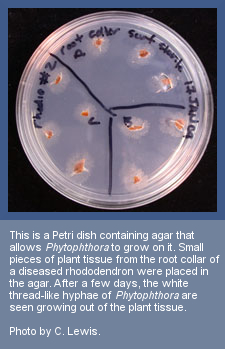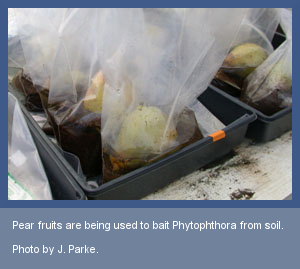Once at the Lab
 Once a plant disease diagnostic lab gets a fresh sample, any of several procedures might be used to detect Phytophthora. Sometimes infected plant tissue, such as roots leaves, or stems, can be cut up, stained, and viewed with a microscope. The presence of many thick-walled spores (oospores or chlamydospores) indicates recent colonization of the plant tissue. However, organisms related to Phytophthora may produce similar structures.
Once a plant disease diagnostic lab gets a fresh sample, any of several procedures might be used to detect Phytophthora. Sometimes infected plant tissue, such as roots leaves, or stems, can be cut up, stained, and viewed with a microscope. The presence of many thick-walled spores (oospores or chlamydospores) indicates recent colonization of the plant tissue. However, organisms related to Phytophthora may produce similar structures.
Several pieces of plant tissue (from near the advancing margin of discolored cambium) can be placed on a shallow jellylike surface called agar in a petri plate. If Phytophthora is present, it may grow out of the plant tissue onto the agar. An experienced laboratory technician can then recognize the growth habit, pattern, colony color, and other characteristics and determine the genus and species of the organism.
The problem with this method is that the fungus may not grow out of the diseased plant material. Plant material must be fairly fresh, and the fungus must be actively growing. Even then, chances are only about 50% that Phytophthora will be detected from any one piece. Many times the plant sample is dried out or completely dead. The chance of obtaining a live fungus from this material is much lower than 50%, if not zero.
 A way around this problem is to "bait" out the pathogen by placing the rotted material in water and floating a healthy piece of plant material (the bait) on top. Commonly used baits include leaves, needles, or hard green pear fruit. The Phytophthora-infected material produces the swimming spores (zoospores) which infects the bait. Chances of obtaining a culture of the fungus from this freshly colonized material are very high. In any case, these procedures take time, several days or weeks if further identification is needed.
A way around this problem is to "bait" out the pathogen by placing the rotted material in water and floating a healthy piece of plant material (the bait) on top. Commonly used baits include leaves, needles, or hard green pear fruit. The Phytophthora-infected material produces the swimming spores (zoospores) which infects the bait. Chances of obtaining a culture of the fungus from this freshly colonized material are very high. In any case, these procedures take time, several days or weeks if further identification is needed.
A laboratory technique called PCR can detect the DNA of specific Phytophthora species even when it is present in small amounts. Plant samples are frozen in liquid nitrogen and then ground up. The small amount of DNA present in the sample is extracted using chemicals such as chloroform and isopropanol. A unique segment of a specific Phytophthora DNA is added. If DNA of the suspected Phytophthora is present in the sample, then, under the right conditions, the unique reference DNA will match up with the Phytophthora DNA. These matched up segments of DNA are copied many times so they can be readily detected. Although the test is very sensitive and can quickly find the DNA of a specific Phytophthora species, it takes special laboratories to do the work. Also these techniques cannot tell us if the fungus is alive or dead.
